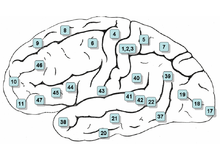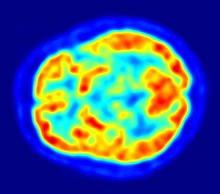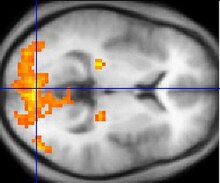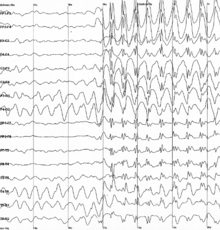Neurolinguistics
Neurolinguistics studies the mechanisms of the human brain that facilitate the knowledge, understanding and acquisition of language, whether spoken, written or with signs established from their experience or from their own programming.. Due to its interdisciplinary nature, neurolinguistics draws its methodology and theory from fields such as neuroscience, linguistics, cognitive science, neurobiology, neuropsychology, and computational science. Much work in neurolinguistics is based on theoretical linguistics and psycholinguistic models and focuses on investigating how the brain can implement the processes that linguistics and psycholinguistics propose as necessary in producing and understanding language.
Neurolinguistics studies the physiological mechanisms by which the brain processes information related to language and evaluates linguistic and psycholinguistic theories, using aphasiology, brain imaging, electrophysiology and computational models.
History
The roots of neurolinguistics lie in the development of aphasiology in the XIX century, the study of deficits disorders (aphasias) that occur as a result of brain damage. Aphasiology attempts to relate structure to function by analyzing the effect of brain injury on language processing. One of the first to discover the connection between an area Particularly concerned with the brain and language processing was Paul Broca, a French surgeon who carried out autopsies on people with speech impairments and found that most of them had brain damage (or lesions). >) in the left frontal lobe, in an area known as Broca's area.
Phrenologists claimed in the early 19th century that different brain regions carried out different functions and that language was controlled primarily by the frontal regions of the brain, but Broca's research was possibly the first to offer empirical evidence for such relationships and has been described as "epoch-making" and as " 34;crucial" for the fields of neurolinguistics and cognitive sciences.
Later, Carl Wernicke proposed that different areas of the brain were specialized for different linguistic tasks, with Broca's area handling speech production and Wernicke's area handling listening comprehension. The work of Broca and de Wernicke established the field of aphasiology and the idea that language can be studied through examination of the physical features of the brain. Aphasiology benefited early in the century XX from the work of Korbinian Brodmann who "mapped" the surface of the brain, dividing it into numbered areas based on each of the areas of cell structure and their functions; these areas, known as Brodmann areas, are widely used in neuroscience today.
The coining of the term "neurolinguistics#34; is attributed to Harry Whitaker, who founded the Journal of Neurolinguistics in 1985.Although aphasiology is the historical heart of neurolinguistics, in recent years this field has expanded considerably, thanks in part to the advent of new brain imaging technologies (such as PET and fMRI) and urgent electrophysiological techniques (EEG and MEG), which can highlight patterns of brain activation while people are engaged in various tasks; electrophysiological techniques, in particular, emerged as a viable method of studying language in the 1980s with the discovery of N400, a brain response with semantic issues in language comprehension. The N400 was the first language-relevant response to be identified, and since its discovery the EEG and MEG have become crucial tools in conducting language investigations.
Aphasiology
Although aphasiology is the historical basis of neurolinguistics, in recent years this field has developed considerably and new technologies have been incorporated into the discipline. Language is a central topic of interest for cognitive neuroscience, and modern brain imaging techniques have contributed considerably to a better understanding of the anatomical organization of language functions. Such techniques include PET and FMRI, which provide high spatial resolution images of energy use in various brain regions during the performance of language processing tasks. Results from these techniques have not contradicted existing results from aphasiology. However, these techniques do not enable high temporal resolution of brain tasks such as sentence comprehension or production. As temporal resolution is extremely important in these matters, scholars also employ the electrophysiological techniques EEG (Electroencephalography) and EMG (Electromyography). They provide millisecond-level resolution, although the nature of the brain mechanism that generates the electrical signals in the scalp is not yet known, making their interpretation difficult. As a result, EEG and EMG are mainly used to test cognitive/computational theories of language architecture, without regard to the precise neurobiological implementation. For example, someone might suspect that of three different categories of words that might end a sentence, two are actually represented by the same mechanism, but the third is represented differently. Noting that these two categories show an identical electrophysiological response that differs from the third would support such a hypothesis.
The discipline of psycholinguistics is closely related to neurolinguistics, psycholinguistics tries to clarify the cognitive mechanisms of language through the traditional techniques of experimental psychology, including analysis of indicators such as «reaction time», «eye movement ",etc.
Another significant methodology in the cognitive neuroscience of language is the computational model that can demonstrate the inconsistency of specific hypotheses about the neural organization of language, while promoting new predictions for future empirical studies. Currently, computer modelers collaborate more actively with brain imagers coordinated also with psychologists in interdisciplinary programs of study. These programs have produced significant new insights into the study of the nature of language, as well as language dysfunctions that affect millions of people, such as stuttering and dyslexia.
Contributions of neurolinguistics
The study of brain lesions is directly related to the study of brain components. This discipline states that the fact that a special lesion in a specific area of the brain affects certain linguistic capacities is direct evidence of the modular organization of language in the brain, according to which different capacities are carried out in specialized areas and focused on the brain.
The first to do this division of the brain was Franz Joseph Gall, a pioneer in phrenology. Although this model was discarded due to lack of accuracy, it opened the doors to the study of the modularly organized brain.
Used technology
The technology used for experiments in neurolinguistics is very important. Brain visualization techniques have contributed to the understanding of the anatomy of the brain and its linguistic functions. Brain imaging methods used in neurolinguistics can be classified into hemodynamic methods, electrophysiological methods, and methods that directly stimulate the cortex.
Hemodynamic methods
Hemodynamic techniques have the advantage of focusing on a specific area of the brain, the blood is responsible for supplying oxygen to that specific area (what is known as the blood oxygen level). These techniques are PET (Positron Emission Tomography) and fMRI (Functional Magnetic Resonance Imaging) and provide high spatial resolution that allows the investigator to determine the location of activity cerebral; temporal resolution (or information about the synchronization of brain activity) but, on the other hand, they are poor in the response of the BOLD signal (contrast dependent on the level of oxygen in the blood) since language processing occurs much more slowly. In addition to showing which parts of the brain perform which specific language tasks or computations, hemodynamic methods have also been used to demonstrate how language architecture in the brain is structured and the distribution of language-related activation change with passage. of time as a function of linguistic exposure.
In addition to PET and fMRI, which show which areas of the brain are activated by certain tasks, the researchers also use diffusion tensor imaging (DTI), which shows the neural pathways connecting different areas of the brain, thus providing an idea of the different areas that interact. Near infrared spectroscopy (fNIRS) is another hemodynamic method used in language tasks.
Electrophysiological Methods
Electrophysiological techniques take advantage of the fact that when a group of neurons fire, they create an electrical dipole, or current. The technique used is EEG (Electroencephalography) and consists of transmitting an electric current through sensors placed on the scalp and measuring the magnetic fields that generate these currents with MEG (Magnetoencephalography). In addition to these non-invasive methods, electrocorticography has been used to study language processing. These techniques are capable of measuring brain activity for a millisecond, helping to study processes such as language comprehension or its production. On the other hand, it is difficult to identify the location of brain activity using EEG, so this technique is mainly used to see how language processes are carried out. EEG and MEG investigations generally focus on evoked potentials (ERPs), which are the different responses of the brain to a particular stimulus. Studies using ERP may focus on the latency of each ERP (how long after the ERP stimulus), amplitude, or topography. Some important components of evoked potentials (ERPs) include the N400, the mismatch potential, the left anterior negativity principles, the P600 and the lateralized preparation potential.
Neurolinguistics as a discipline
The discipline of psycholinguistics is closely related to neurolinguistics, psycholinguistics studies the processes that underlie language, using the traditional techniques of experimental psychology, including analysis of indicators such as «time reaction”, “eye movement”, etc. Today there is much collaboration between psycholinguistic and neurolinguistic theories. Much of the work in neurolinguistics involves studying and evaluating the theories put forward by psycholinguists and theoretical linguists. In general, theoretical linguists propose models to explain the structure of language and how its information is organized, psycholinguists propose models and algorithms to explain how language information is processed in the mind, and neurolinguists, on the other hand, analyze brain activity to infer how biological structures carry out these psycholinguistic processing algorithms. For example, in the cognitive neuroscience of language another significant methodology is the computational model that can demonstrate the inconsistency of specific hypotheses about the neural organization of language, while promoting new predictions for future empirical studies. Currently, computer modelers collaborate more actively with brain imagers coordinated also with psychologists in interdisciplinary programs of study. These programs have produced significant new insights into the study of the nature of language, as well as language dysfunctions that affect millions of people, such as stuttering and dyslexia.
Neurolinguistic research is conducted in all major areas of linguistics. The following indicates how such research addresses the most important sub-disciplines of this:
- Phonetics: how the brain selects at the muscle level the articulation of the sounds of the spoken chain.
- Fonology: how the phenological system of a tongue is represented in the brain.
- Morphology and Syntax: How the brain selects those phonemes that determine words and combines them to form prayers.
- lexicology and semantics: how the brain stores and accesses the words a person knows and can structure to develop understanding.
The neurolinguistics relates and studies the processes that underlie language, with the brain and behavior. He also investigates various topics, including where language information is processed, how language processing develops over time, how neurophysiology can contribute to speech-language pathology, and how brain structures are related to speech. language acquisition and learning. Regarding the last question, it has been established that in the acquisition of the mother tongue, children from all linguistic backgrounds go through similar stages (such as babbling). Some neurolinguistic research is directed at finding correlations between stages of language development and stages of brain development, while others study the physical changes the brain undergoes during adult second language acquisition.
Contenido relacionado
Coprophilia
Narcissism
Hawaiian language




